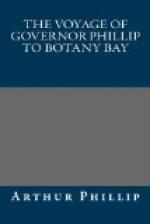The Alexander and the Friendship had now run from the latitude of 10 deg. 44’ south, and longitude 161 deg. 30’ east, to the latitude of 7 deg. 10’ south, and longitude 156 deg. 50’ east, the whole way nearly in sight of land. As, therefore, proceeding westward, to the south of the next land, might have entangled them with New Guinea, Lieutenant Shortland determined to try the passage which was now before him; and being very well convinced, before it was dark, that the way was clear, kept under a commanding sail all night. At ten o’clock in the evening, the Alexander was nearly a-breast of the two points that form the passage, and the soundings were very irregular, from ten to thirty fathoms, on a soft, sandy bottom: the anchors were therefore cleared, that they might immediately be dropped if it should prove necessary.
8 August 1788
At two in the morning of August the 8th, a strong ripple of a current was very plainly to be perceived; and by five the ship had nearly cleared the straits. She had then the following bearings: Cape Alexander, south-east; some islands and rocks that lie off the most western island of those which form the straits, west by south; and the remotest point in sight to the north-westward, north-west by north, distant fourteen or fifteen leagues. This point is remarkably high and forms the centre of a large body of land, between the first and last point of the straits on the western side, which were called Cape Friendship, and Cape Le Cras.
These straits Lieutenant Shortland judged to be between four and five leagues in length, and about seven or eight miles broad, running in a north-west direction; and, conceiving himself to be the first navigator who had sailed through them, he ventured to give them the name of Shortland’s Straits. On comparing his account with the narrative of M. Bougainville, which he had not then by him, there seems to be reason to suspect that this is the same passage through which that navigator sailed at the latter end of June, 1768; and that the island supposed to be called Simboo, is the same which was then named Choiseul Island. To corroborate this suspicion, M. Bougainville’s description of the canoes and persons of the natives agrees entirely, as far as it goes, with that given by Mr. Shortland*. A small difference in longitude affords the chief reason for doubting the identity of the passage, which, should it be proved, will not detract at all from the merit of the latter navigator, who proceeded entirely by his own attention and sagacity, in a sea unknown to himself and those who were with him, which, if not wholly unexplored, had not, however, been surveyed before with equal minuteness of observation.
[* Some of the vessels indeed were larger. “Il y avoit vingt-deux hommes dans la plus grande, dans les moyennes, huit ont dix, deux ou trois dans les plus petites. Ces pirogues paroissoient bien faites; elles ont I’avant et I’amere fort releves, etc. Ils portent des bracelets, et des plaques au front et sur le col. J’ignore de quelle matiere, elle m’a paru etre blanche.” Boug. Chap. v. p. 264.]




